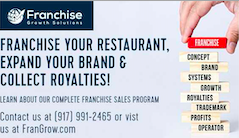GETTING FRANCHISEES OFF TO A GREAT START…The likelihood of a franchise owner “going rogue” when a company is transparent in its expectations lessens. Franchisees know what is expected of them.
Getting New Franchisees Off to a Great Start
Prepare them for business ownership through the onboarding and training process.
By Gary Occhiogrosso – Managing Partner of Franchise Growth Solutions, LLC.
Photo by Perry Grone on Unsplash
When training new franchisees, there is a term that is used regularly but has received a lot of criticism “Onboarding” Many Franchisors believe that the “onboarding process” begins once a candidate is awarded the franchise. I coach this process is a different way. At Franchise Growth Solutions we know that the onboarding process begins from the very first interaction the company has with the franchise prospect.
Getting to the Goal
That said, let’s take a step back and first explore the goal of proper onboarding. In my opinion, the main focus is to create value for the brand in the minds eye of the candidate. Without value and respect for the brand, all the training in the world will not produce a franchisee capable of living up to his or her full potential as the operating franchisee.
Although franchisee training is often seen as a means to an end because of how quick paced it is and how much information is packed into training sessions, in and of itself training is certainly not the sole answer in producing quality franchisees. Through the years I’ve trained franchisors to understand that in order to successfully orientate a new franchisee; Mission, Culture and Core Values of the brand must be communicated to and embraced by the franchisee. Here again I cannot emphasize enough that franchisors must start building value and respect for the brand during the recruitment phase. It is during that time, potential franchisees and the franchisor should engage in meaningful, mindful conversation so that the franchise candidate understands what is expected of them and the Franchisor should understand what the franchisee expects in return. It’s a simple (but not easy) process that can lead to rejecting a candidate and losing the deal. However, trust me when I say, losing that candidate is a far better outcome than bringing the wrong franchisee into the system only to wreak havoc, compromise brand standards and lobby additional, otherwise satisfied franchisees into their negative mindset.
Successful onboarding and training requires transparency, consistency and follow up.
The likelihood of a franchise owner “going rogue” when a company is transparent in its expectations lessens. Franchisees know what is expected of them. In addition, the Franchisor’s support personnel should be out in the field in front of the franchise owner, coaching, counseling and working with the franchisee to achieve optimum results, financially as well as making sure the business is providing options consistent with the franchisees lifestyle goals. Supplying ongoing training that places resources within reach of the franchisee is not only vital at the onboarding phase but throughout the lifecycle of the business relationship.
Initial Training & Support
This approach helps franchisees adapt as the brand grows and systems evolve. Preparing franchisees to deal with the issues that may come up along the way is key to building a successful franchise system. Ultimately solid onboarding and training should expose the franchisee to detailed information so the franchisee knows what the company expects and they can live up to the “Brand Mission”. Initial and ongoing training should support the idea that following the system is the most important aspect leading to the success of the business. This approach puts franchisees in a better position to make sound decisions concerning the business with little outside assistance and with little room to “reinvent the wheel”.

Franchisees need to be held accountable for holding the same high standards as the franchisor. In order to do this, your company culture, value proposition, training program, operations manuals, job aids and other franchisor supplied tools should be carefully develop, tested, reviewed and updated as necessary. The onboarding process and training program is never “done”. As the franchisor it is you job to insure that franchisees have access to the tools and support needed to grow and thrive.
Get new franchisees off to a great start through a sound onboarding process that starts at the first hello. Recruit and vet your candidates thoroughly, be certain they are a fit for you brand culture and buy into your mission statement. Provide them with the tools and support needed to navigate system changes as they occur. Give the franchisees the foundation they need to grow, develop, and succeed as business owners. An excellent franchise system, built this way from the start makes it easier for franchisees to overcome challenging situations as they occur, and they will occur.
==================================
About the Author:
Gary Occhiogrosso is the Managing Partner of Franchise Growth Solutions, which is a co-operative based franchise development and sales firm. http://www.frangrow.com
Their “Coach, Mentor & Grow Program” focuses on helping Franchisors with their franchise development, strategic planning, advertising, selling franchises and guiding franchisors in raising growth capital.
Gary started his career in franchising as a franchisee of Dunkin Donuts before launching the Ranch *1 Franchise program with it’s founders. He is the former President of TRUFOODS, LLC a 100+ unit, multi brand franchisor and former COO of Desert Moon Fresh Mexican Grille. He advises several emerging and growth brands in the franchise industry
Gary was selected as “Top 25 Fast Casual Restaurant Executive in the USA” by Fast Casual Magazine and named “Top 50 CXO’s” by SmartCEO Magazine. In addition Gary is an adjunct instructor at New York University teaching Restaurant Concept & Business Development as well Entrepreneurship. He has published numerous articles on the topics of Franchising, Entrepreneurship, Sales and Marketing. He is also the host of the “Small Business & Franchise Show” broadcast in New York City and the founder of http://www.FranchiseMoneyMaker.com








